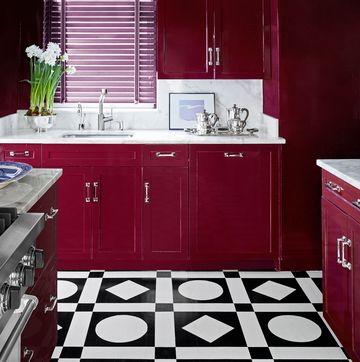There was no nonsense in the Victorian kitchen, buried in the basement or back of the house. Over the past century, kitchens have evolved steadily. They blossomed into cheerful rooms as the 20th century approached, where housewives cooked three meals a day while watching their children. In the wake of World War II, kitchens opened to adjacent rooms, with islands that held appliances and storage that had been lost when walls were removed.
Basically, that’s what’s going on with kitchens today. What will happen when the white kitchen trend is finally over? “People are very attached to this light and airy thing, which is one of my biggest pet peeves, because not everything needs to be light and airy,” says Danielle Colding, who painted her kitchen with yellow cabinets recently. The key to dimension is contrast. If everything is light, you won’t see it.
As designer Brittany Marom says, “It’s cool to have a moody kitchen,” but it’s tough to constantly maintain your white cabinets and marble countertops.”
We have been stuck on the white kitchen because of a meetup of influences. The belief is that because cuisines are so central to our lives, they shouldn’t bother us. In addition, there is the Instagram phenomenon of some white ones taking on the totemic allure of the Parthenon, which is a fear that a unique kitchen will affect the home’s resale value.
In the kitchen of a villa on Capri, Italy, commercial appliances contrast with majolica tiles and terrazzo.
As Colding says: “They’re saying, ‘This kitchen is for me, and I want to enjoy it’.” The needle is finally moving after two years of confinement.
There is no rule that says everything must be light and airy.
Besides yielding greater visual daring, this attitude also decreases preciousness. The owners of an early-20th-century mansion in Tuxedo Park, New York, decided not to rip out the 1960s St. Charles kitchen but to paint it turquoise instead. They also painted the wood floor. “It’s their favorite room in the house,” he says.
It is not unusual for Emma Beryl’s clients to gravitate towards “living” materials such as stone and wood “that will age with them.” These people are more comfortable with stained and nicked marble and the idea that “your home should look more like a home.”
Those seeking alternatives to natural stone can turn to engineered quartz slabs from companies like Caesarstone and Cambria, which are highly stain and scratch resistant and are available in a variety of colors and finishes.
It is becoming increasingly difficult to find high-tech appliances from brands like Sub-Zero, Wolf, and LG. Big Chill’s retro-style stove has brushed copper trim and a pastel green finish, while Bertazzoni’s ranges come in sleek automotive paint inspired by Italian racing cars for color fans. In the past, La Cornue was one of the only brands to offer colorful, fun ranges, but now that has multiplied tenfold.
While there have been many advances in modern kitchens, one kind still harks back to Victorian times. He says more clients are requesting discreet chefs’ kitchens for private cooks to prepare meals. “The old-fashioned dumbwaiters are back in style,” he said, since these spaces are often located on lower floors.
KITCHENS FOR THE OUTDOORS
Architects at the American Institute of Architects found outdoor kitchens to be the most popular feature of kitchens in 2021.
Material Considerations
Cabinets made from teak seem natural, but Brittany Marom says they need to be stained every year to maintain their appearance.
Take the time to enjoy yourself
Emma Beryl recalls doing a rosé tap recently.
Management should be considered
Ernest de la Torre, a designer from Los Angeles, believes the outdoor kitchen that can store what you need has not yet been invented.
